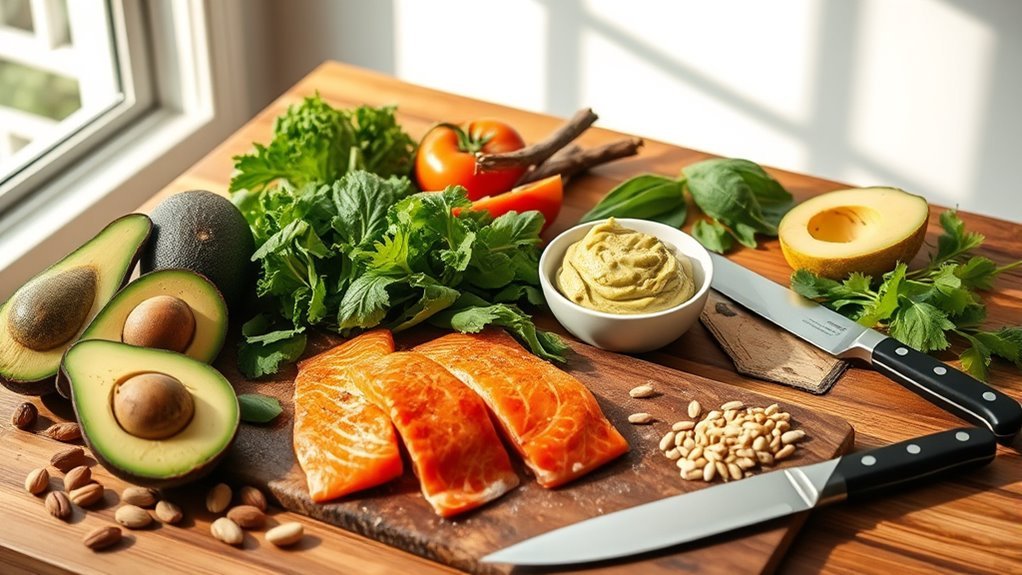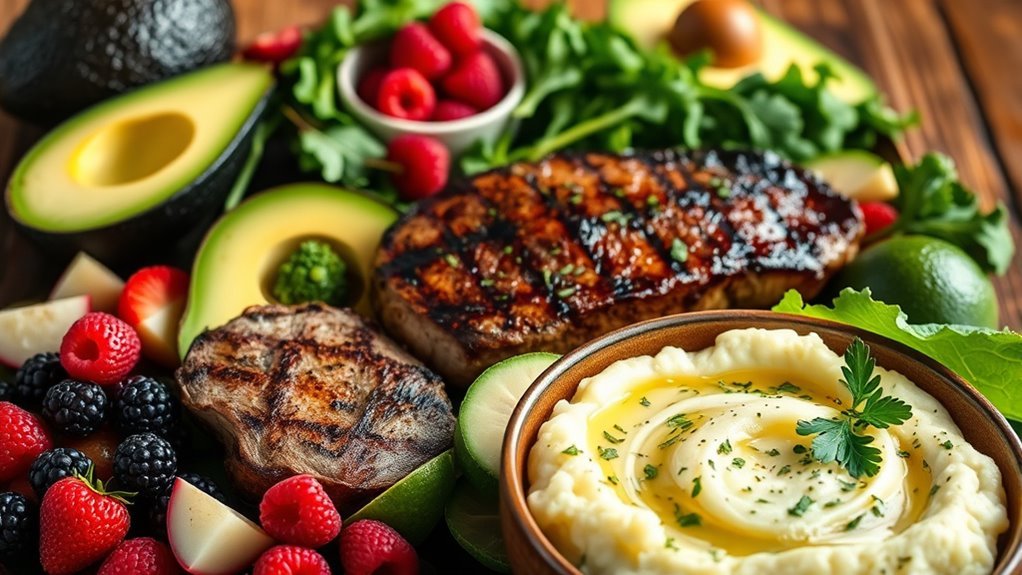To do keto, drastically cut your carbohydrate intake and replace it with healthy fats, aiming for a macronutrient ratio of about 70% fat, 25% protein, and 5% carbohydrates. This diet shifts your body into ketosis, where it burns fat for energy. Focus on whole foods like avocados, nuts, and lean proteins, and track your macros to avoid common pitfalls. Staying hydrated and mindful of electrolytes is essential. Discover more about meal planning and avoiding mistakes on your keto journey.
Understanding the Basics of the Keto Diet

When you’re considering the keto diet, it’s essential to understand its foundational principles. The core of keto lies in drastically reducing carbohydrate intake and replacing it with healthy fats. Many keto misconceptions, like the belief that you can eat unlimited fats without consequences, can lead to beginner challenges. You might find it tough to navigate food choices initially, as the diet requires a shift from conventional eating habits. Focusing on whole foods—like avocados, nuts, and lean proteins—will help you avoid pitfalls. Additionally, be prepared to educate yourself about tracking macronutrients, as this is vital for success. Embracing these basics empowers you to pursue the keto lifestyle with confidence and clarity, allowing you to enjoy your newfound freedom in food choices.
The Science Behind Ketosis

To understand the science behind ketosis, it’s essential to grasp how your body shifts from using carbohydrates to fats for energy. This metabolic state not only aids in weight loss but also offers various health benefits, including improved mental clarity and reduced inflammation. By examining the mechanics of the ketogenic diet, you’ll see how this process unfolds and its impact on your overall well-being.
Understanding Ketosis Process
Ketosis is a metabolic state that occurs when your body shifts from relying on carbohydrates for energy to utilizing fat as its primary fuel source. During this process, your liver converts fatty acids into ketones, which serve as an alternative energy source. You’ll likely experience ketosis symptoms such as increased energy, reduced hunger, and mental clarity as your body adapts. The ketosis duration varies among individuals, often taking a few days to weeks to fully establish. Factors like diet composition and activity level can influence this timeframe. Understanding these mechanisms empowers you to navigate your keto journey effectively, providing the freedom to harness your body’s natural ability to burn fat for fuel. Embrace the process, and enjoy the transformation.
Benefits of Ketosis
While many people turn to the keto diet for weight loss, the benefits of ketosis extend far beyond just shedding pounds. You’ll experience increased energy levels as your body efficiently burns fat for fuel, providing sustained vigor throughout the day. Mental clarity often improves, enhancing brain function and focus. Ketosis supports appetite control, helping you manage cravings and maintain a healthy weight. It can stabilize blood sugar levels, promoting heart health and reducing the risk of chronic diseases. Additionally, inflammation reduction benefits your overall wellbeing, while boosting endurance performance during physical activities. Finally, you’ll notice improvements in digestive health, contributing to a balanced lifestyle that empowers you to thrive on your keto journey.
Ketogenic Diet Mechanics
As your body shifts from using carbohydrates to fats for energy, the mechanics of the ketogenic diet come into play, leading to a metabolic state known as ketosis. During ketosis, your liver converts fatty acids into ketones, providing an efficient energy source. This change requires careful keto meal timing, ensuring you consume low-carb meals at strategic intervals to maintain ketosis. Some people also incorporate carb cycling, where you periodically increase carb intake to recharge glycogen stores without disrupting ketosis long-term. This method can enhance metabolic flexibility, helping you adapt to varying energy demands. Understanding these mechanics empowers you to optimize your ketogenic journey, granting you the freedom to enjoy a lifestyle that supports your health goals.
Macronutrient Breakdown: What to Eat

To successfully follow a keto diet, understanding macronutrient ratios is essential. You’ll need to focus on ideal fat sources while also meeting your protein requirements to maintain muscle mass and overall health. By carefully selecting your food choices, you can optimize your body’s shift into ketosis.
Ideal Fat Sources
When starting on a ketogenic diet, selecting the right fat sources is essential for achieving and maintaining ketosis. Focus on incorporating healthy oils like olive oil and coconut products into your meals. Nut butters are excellent for snacking, while fatty fish provides crucial omega-3s. Don’t overlook the avocado benefits; they’re rich in monounsaturated fats and fiber. Different cheese varieties can add flavor and fat, enhancing your dishes. You can also enjoy full-fat dairy and grass-fed butter, which are great for cooking and baking. However, be cautious with seed oils, as they may not align with keto principles. By choosing these ideal fat sources, you’ll support your keto journey while enjoying delicious, satisfying meals.
Protein Requirements Explained
Incorporating the right amount of protein is essential for a successful ketogenic diet. Protein helps maintain muscle mass while you burn fat for energy. Aim for roughly 20-25% of your total daily calories from protein, focusing on high-quality protein sources. Remember, protein timing can also play a role; spreading your intake throughout the day can optimize muscle synthesis.
Here’s a quick overview of protein sources:
| Protein Source | Serving Size | Protein Content |
|---|---|---|
| Chicken Breast | 3 oz | 26 g |
| Salmon | 3 oz | 22 g |
| Eggs | 1 large | 6 g |
| Greek Yogurt | 1 cup | 20 g |
| Tofu | 3 oz | 10 g |
Choose wisely, and enjoy the freedom of health!
Meal Planning and Preparation Tips
Effective meal planning and preparation can considerably enhance your success on a keto diet. Start by creating a grocery list that aligns with your meal prep goals, ensuring you have all your kitchen essentials. Focus on portion control to prevent overeating and maintain your macros. Explore recipe ideas that incorporate a variety of keto-friendly ingredients to keep meals exciting. Batch cooking is a fantastic strategy; prepare larger quantities and store them for convenient access. Prioritize food storage solutions to keep your meals fresh and organized. When dining out, look for keto options and apply your time management skills to streamline your meal prep process. With these tips, you’ll enjoy meal variety while effortlessly sticking to your keto lifestyle.
Snacks and Keto-Friendly Foods
While you’re managing the keto diet, choosing the right snacks can make a significant difference in maintaining your low-carb lifestyle. Healthy snacks like nut options and cheese varieties are excellent choices, providing protein and fats to keep you satisfied. Consider low carb treats such as veggie dips paired with fresh, crunchy vegetables for a revitalizing snack. For quick bites on the go, protein bars offer a convenient, portable food option that aligns with your keto goals. Don’t forget to indulge in keto desserts occasionally; they can satisfy your sweet tooth without derailing your progress. With these snack ideas in hand, you’ll find it easier to stay committed to your keto journey while enjoying flavorful, satisfying foods.
Common Mistakes to Avoid
Many people find themselves stumbling on their keto journey due to a few common mistakes that can hinder progress. One of the biggest keto pitfalls is not tracking your macros accurately. It’s easy to underestimate carb intake, especially with hidden sugars in processed foods. Another common misconception is that all fats are created equal; focus on healthy fats like avocados and olive oil while avoiding trans fats. Additionally, some may plunge into keto without adequately preparing, leading to feelings of deprivation or fatigue. Finally, neglecting hydration and electrolytes can result in the “keto flu.” By being aware of these mistakes, you can navigate your keto journey more effectively and enjoy the freedom that comes with a well-planned lifestyle.
Monitoring Your Progress
How do you know if your keto journey is on the right track? Monitoring your progress is essential for making informed dietary adjustments. Use a keto app for systematic progress tracking, noting weight fluctuations, body measurements, and health indicators.
| Metric | Frequency | Notes |
|---|---|---|
| Weight | Weekly | Watch for trends |
| Body Measurements | Bi-weekly | Measure waist, hips |
| Energy Levels | Daily | Rate your energy levels |
| Mood Changes | Daily | Note emotional shifts |
Visual progress is motivating. Keep an eye on fitness milestones to celebrate small victories. By tracking these factors, you’ll better understand how your body responds and what works best for you.
Staying Motivated on Your Keto Journey
Staying motivated on your keto journey can be challenging, especially when faced with cravings or plateaus. To succeed, consider adopting effective motivation strategies like setting clear, achievable goals. Surround yourself with keto support, such as accountability partners, who can help you stay focused and share success stories that inspire resilience. Engage with your community, whether online or locally, to foster a sense of belonging and encouragement. Use positive affirmations to reinforce your commitment, reminding yourself why you started. Develop a reward system for milestones reached, which can provide additional motivation. By practicing mental resilience and employing these techniques, you’ll find it easier to overcome cravings and stay on track toward your keto goals.


